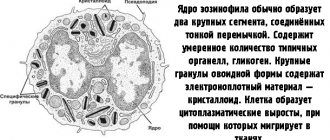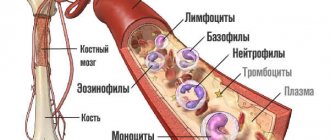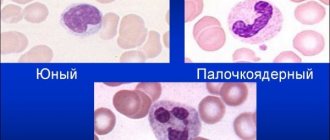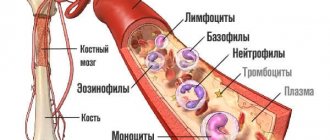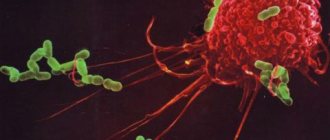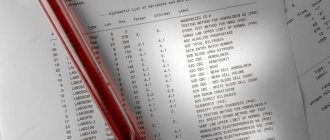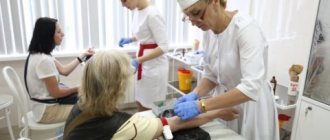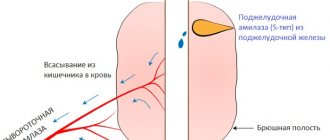Segmented neutrophils are a type of leukocyte whose nucleus is divided into segments.
They spread throughout the body through the bloodstream and identify pathological cells, and then absorb them. Normally, segmented neutrophils in a child’s blood in a blood test constitute from 30 to 70% of the total number of leukocytes, depending on age. These cells are very important for the body as they protect the body from germs and microbial infections.
Segmented neutrophils are found in the blood and actively move in it due to the fact that they
they have legs similar to those of an amoeba.
The first leukocyte that reaches the enemy envelops it and releases special substances into the blood that attract other segmented neutrophils in the blood.
When there is a rapid infectious microbial process in the body, segmented neutrophils in the child will be increased in the blood test.
If the analysis results show an increase in this indicator, a full examination is required to identify the cause of the pathology and timely treatment.
How to prepare a child for analysis?
It is important for adults to properly prepare the baby for the procedure.
First of all, you need to explain to the child what will happen during the procedure and convince him that it is not painful and there is nothing to be afraid of. You should also first consult with a pediatrician, who will give all the recommendations on how to prepare your child.
The main ones are:
- Arriving for the test 30 minutes before the time of the procedure - the child needs to stay indoors so that walking and the temperature difference between the room and the street do not disturb the picture.
- Lack of physical activity 12 hours before sampling - you should not allow your child to play actively in the evening, and you should not go with your child to the tests on foot if the distance to the laboratory is more than 500 meters.
- Refusal to eat 3 hours before the procedure - you can give the baby something to drink, but only with clean water and in a volume of no more than 1 glass. If it was not possible to come to an agreement with the children, and they still ate something, the blood donation will be rescheduled.
When a child is highly nervous, it is necessary, in consultation with the doctor, to select a mild sedative that will help avoid stress and a jump in performance due to it.
Neutrophil segment is normal in children
Every parent is obliged to monitor the health of their child. And a general blood test is an important assistant in this difficult matter.
After taking a blood test, the results are interpreted and studied by a doctor. The presence of normal indicators indicates the health of the child’s body.
If the doctor finds any deviations from the usual values, the parents will be asked to conduct additional examinations of the child.
What are neutrophils?
Neutrophils in the blood are one of the types of white blood cells - leukocytes and granulocytes. Being in the blood, they occupy about 75% of the total number of white blood cells.
Neutrophil granulocytes are a very significant component of leukocytes. Their number will necessarily be recorded in the leukocyte formula of the blood, and is designated as neut .
A neutrophil count that does not fall outside the established range indicates that the child’s immune system is functioning correctly. It quite effectively protects the child’s body from bacteria and viruses entering it.
What role do neutrophils play?
The production of neutrophil granulocytes occurs in the red bone marrow. This organ plays a major role in the processes of hemo- and immunopoiesis.
The lifespan of neutrophils is short (about a few hours), so they are regularly renewed.
A characteristic feature of newly formed cells is the granularity of their internal structure.
The granules contain antibacterial substances, through which blood cells provide the following functions:
- Protecting the body from the penetration of bacteria, viruses and infections.
- Capture and absorption of foreign particles - phagocytosis.
If the specified functions are performed correctly, the human body has good immunity. If there is a change in the concentration of neutrophils, we can talk about the presence of a disease.
Normal indicators
Cells circulating in the blood can be classified as follows:
- Mature neutrophils are segmented.
- Immature neutrophils are band neutrophils.
The nucleus of mature cells is divided into segments (hence the name), and in immature cells it visually looks like solid curved rods.
In the blood of a healthy person, there are much fewer young cells than segmented cells.
In a child who does not suffer from any diseases, the level of mature cells varies between 16-70%. The exact indicator does not change depending on gender, but is directly related to the age of the child.
Table “Neutrophils in children are normal in blood tests”
| Age | Norm of mature (segmented) neutrophils | Norm of immature (band) neutrophils |
| Infants, first week | 45-80 % | from 3 to 17% |
| Infants, first week | 45-80 % | 1-3 % |
| Babies under 1 year old | 15-45 % | 0.5 to 1% |
| Teenage children (up to 13 years old) | 35-62 % | 1-5 % |
| Children over 13 years of age The norm of neutrophils in the blood of children corresponds to the indicators for an adult | 47-72 % | 1-6 % |
The maximum number of immature neutrophils is found only in newborn babies. Over time, these indicators decrease, and the main place is given to segmented cells.
This occurs because only mature neutrophils are able to resist harmful particles penetrating from the outside. A stable level of immunity is directly related to the optimal level of granulocytes for age.
Deviations from usual values
There are cases when the norm of neutrophils in children is exceeded or, conversely, reduced. Both conditions have certain symptoms, causes and consequences.
Increasing values
The number of granulocytes in a child’s blood exceeding acceptable parameters is fraught with serious consequences.
The absence of any symptoms and a slight increase in neutrophils indicate factors such as:
- Excessive physical activity.
- Stressful situations, overexertion.
- Blood loss.
Usually in such situations, anxiety is not justified.
The presence of the disease can be judged by a large jump in the level of neutrophils in a child after one year. A higher than usual number of granulocytes indicates the development of neutrophilia in the baby.
The causes of this disease are as follows:
- Malignant blood diseases.
- Trophic ulcers.
- Vaccinations.
- Otitis, pneumonia, tonsillitis, sepsis, occurring in acute form.
- Diabetes.
- Purulent tissue inflammation.
Inflammatory processes are directly related to the level of neutrophils in the blood: the higher it is, the stronger the inflammation. To alleviate the condition, it is necessary to immediately identify the cause of the disease and prescribe appropriate therapy.
Decreased neutrophil values in peripheral blood
A decrease in the level of neutrophils indicates a deterioration in the condition of the child’s immune system. This occurs due to insufficient production of blood cells, their rapid destruction or their incorrect distribution. The resulting clinical and laboratory syndrome is called neutropenia.
The reasons for the development of this pathology are as follows:
- Bone marrow disorders.
- Leukemia in acute form.
- Dramatic weight loss.
- Fungal disease.
- ARVI, hepatitis and other viral diseases.
- Intoxication.
- Irradiation.
- History of anaphylactic shock.
- Side effects of taking certain medications.
There is no reason for concern if, despite the low level of neutrophils, the baby under the age of one year feels well. Blood cell levels return to normal when the child reaches three years of age.
Treatment
Only a specialist can select the necessary therapy when the level of neutrophils changes. Independent uncontrolled use of various drugs will provoke a sharp decrease or increase in the indicator to critical levels.
Decrease in indicators
If the granulocyte count is elevated, the following medications may be prescribed to a small patient, depending on the indications:
- Immunosuppressants and cytostatics,
- Anti-inflammatory.
- Antiviral.
- Antibacterial.
Recommended:
- Diets.
- Physiotherapeutic measures according to indications,
- Exercise therapy.
Complex therapy should be carried out under the supervision of blood tests.
Reference values of the indicator by age
Depending on the age of the child, segmented leukocytes are present in the blood in greater or lesser quantities. An excessive amount of them is called neutrophilia, and a low amount is called neutropenia.
Normal blood levels are presented in the table:
| Age | Norm |
| newborns up to 5 days | 70% |
| in infants from 5 days to 1 month | 55% |
| from 1 month to 1 year | 30% |
| from one year to 5 years | 35% |
| from 5 years to 10 years | 55% |
| over 10 years old | 60% |
An increase in neutrophils in a child’s blood is an alarming sign that cannot be ignored, as this could lead to serious infectious diseases being missed.
It is especially important to conduct a full examination if the level of leukocytes is elevated in a child under 3 years of age, since at this age the child cannot yet correctly describe the symptoms and accurately characterize his condition, which makes it difficult to timely and accurately identify the pathology.
What are segmented neutrophils?
These types of neutrophils are called segmented neutrophils because they contain segments that make up the nucleus.
In some cases they are called granular leukocytes. It is thanks to the segments that they migrate with the blood to various organs.
Infiltrating into the tissues of internal organs, neutrophils secrete pathogenic bacteria, absorb and eliminate them.
There is a form of rod-shaped neutrophils, which are immature cells. They ripen and transform into segmented ones.
Mature neutrophils have a nucleus divided into segments, therefore they are present in the blood longer, unlike immature ones (from two to eight hours). When examining mature neutrophils with nuclei, there are always more than rod-shaped ones. But deviations from the norm of one and the second type of neutrophils indicate the presence of a disease (in some cases serious). In this regard, there is no need to try to decrypt it yourself after analysis.
The doctor, having looked at the test results, will be able to determine the presence or absence of pathology and will make an accurate conclusion so that therapy can be started on time.
The level of maturity of neutrophils is distinguished by stages:
- A relatively undifferentiated cell with a large oval nucleus and a large nucleolus; it lacks granules.
- It differs from the myeloblast in its larger size, uneven color and caliber of chromatin threads in the nucleus.
- Large, basophilic granules, often not filling the cytoplasm too densely, but the nucleus is covered.
- A cell of the granulocytic series of leukopoiesis, arising from a myelocyte and being the precursor of a rod-nuclear granulocyte.
- Immature neutrophils that are released into the blood when infections occur in the body.
- Cells with a pronounced protective function, which take the brunt of the attack and lead to the destruction of pathogens.
By their quantity in the blood, you can determine the presence of a bacterial infection and learn about its activity in the body.
There are also two concepts in medicine when the number of neutrophils is increased or decreased:
- Neutrophilia - an increase in the number of neutrophils - is considered a reflection of a kind of protection of the body from infections and inflammatory diseases.
- Neutropenia is a decrease in the number, which indicates a multifunctional or organic inhibition of hematopoiesis in the bone marrow or intensive destruction of neutrophils under the influence of antibodies to leukocytes, toxic conditions.
Symptoms of neutropenia
Signs by which you can find out that the level of neutrophils deviates from the norm and is low:
- excessive sweating;
- dysfunction of the heart;
- increased emotionality;
- sudden loss of body weight.
Since similar signs correspond to most diseases, the best option would be to go to the clinic for further examination and testing.
A decrease in the number of neutrophils in the blood can occur not only during infections, but also when taking certain medications.
Reasons for low performance
In children, a decrease in segmented neutrophils (neutropenia) may also be observed.
The cause of this pathology is long-term infections, in which the body uses up protective cells faster than it can produce them. The phenomenon does not occur often and goes away completely after the disease that caused it is eliminated.
The name of the pathology when neutrophils are low is neutropenia. Thus, the deviation develops with bone marrow lesions and blood diseases.
If chemotherapy or radiation therapy, as well as various immunosuppressants and heavy painkillers are used for their treatment, the indicators also decrease.
A small percentage of children have a congenital autosomal recessive disease in which segmented neutrophils are completely absent from the body. The mortality rate in infants with this pathology is very high, especially in the first year of life.
Why does the number of neutrophils decrease?
A decrease in the number of cells (neutropenia) may be hereditary. If you know about such characteristics in one of the baby’s parents, you should inform your doctor about it.
Other factors that can cause neutropenia:
- deficiency of B vitamins, copper, iron, and other microelements;
- long-term use of analgesics, antispasmodics, cytostatics and some other drugs;
- long-term physical activity;
- stress (usually due to a family situation or difficult living conditions, but can also be caused by school workload);
- bacterial and fungal infections;
- viral diseases (measles, chickenpox, rubella, influenza, HIV, herpes, etc.);
- bone marrow pathologies (bone marrow aplasia or hypoplasia, or hereditary diseases affecting the synthesis of cells and their release into the bloodstream).
How does neutropenia manifest in a child?
If the cause of neutropenia is a long-term infection or taking medications, correction of the treatment of underlying diseases is required. If there is no active pathological process, the stages of treatment depend on the child’s well-being:
Chronic moderate neutropenia or a decrease in the number of neutrophils in children under 3 years of age may not manifest itself. In this case, you should focus on the child’s condition and the pace of his development. In most cases, no special treatment is required.
If the cell level has not stabilized after 3 years, or the child is developmentally delayed, gets tired quickly, has a runny nose, or often suffers from colds for a long time, this is a reason for additional examination and treatment. Perhaps the problem can be solved by vitamin therapy, changing the child’s diet and daily routine.
If the cause is stress or school and extracurricular workload, you need to find a way to get rid of them. You may have to give up some clubs during primary school age. The child will be able to return to them when he grows up and gets stronger.
If a decrease in the number of less than 500 in 1 ml of blood is diagnosed, most doctors consider it appropriate to prescribe antibiotic therapy, even if additional examination does not reveal the causes of the disease.
This measure allows both to extinguish a hidden pathological process and protect the child from possible bacterial infection against the background of decreased immunity. As a rule, such therapy gives a positive result.
Measures to normalize indicators
Treatment of the blood picture disorder itself is not carried out directly. Any attempts to directly influence high neutrophils are unacceptable, as this will blur the picture of the disease and will not allow timely treatment of the child.
To identify the disease that caused the child to have elevated neutrophils, additional blood tests, x-rays, tomography and various smears are taken.
It is also necessary to check for the presence of parasites in the body, since they often affect the concentration of neutrophils in children.
There are often cases when blood picture disorders are the only manifestations of pathology in the child’s body.
When the doctor has reasons to suspect the presence of an inflammatory process in a child, a blood test is prescribed without fail.
In case of a long-term illness, several tests can be performed at certain periods of time to monitor the baby’s condition and not to miss a pathological increase in segmented neutrophils.
Neutrophils in the leukocyte formula
Neutrophils (the norm in children by age decreases during the first year of life and increases until adulthood) are most indicative in the form of a leukocyte formula (leukogram). A leukogram is the ratio of different types of “white” blood cells in the body, which is compiled by counting each type of cell in the visible field of a blood smear under a microscope.
The types of neutrophils in the leukogram are arranged according to the degree of maturity from left to right. With an increase in the number of rod bodies or the appearance of precursors (metamyelocytes, myelocytes, promyelocytes, and especially blasts), we speak of a “shift to the left”; with decreased values of “rods” or the detection of a large number of segmented neutrophils with the number of segments of more than 5, we speak of a “shift to the right.”
Each of these violations indicates a deviation of the health status from the norm or significant pathologies.
Leukocyte indicators are expressed in the following units:
- Absolute (number of cells/particles).
- Relative. Expressed as a percentage.
Absolute have identical meanings in SI units:
- (number)/l (an example of the norm in adults is 4400000000);
- (number)*109/l – cells per liter of blood (4.4);
- cells/l – cells per liter of blood (4400000000);
- G/l – grams per liter of blood (4.4);
- Gpart/l – grams or particles per liter of blood (4.4).
Also measured in traditional measurement units:
- (number) *103/μl (1000/μl) – cells in a microliter (μl) of blood (4.4);
- (number)*103/mm3 (1000/mm3) – cells per cubic millimeter of blood (4.4);
- c/μl – cells per microliter (4.4);
- k/mm3 - cells per cubic millimeter (4.4);
- cells/μl – cells in a microliter (4400);
- cells/mm3 – cells per cubic millimeter (4400).
Prevention of increased performance
There are some preventive actions that can improve the child’s condition and strengthen his immune system.
Recommendations for preventing an increase in segmented neutrophils include:
- Systematic hardening from the earliest possible age.
- Regular physical activity.
- High-quality balanced nutrition.
If a doctor prescribes a blood test, you should not refuse it, since the baby’s health depends on the timely detection of abnormalities.
Functions of segmented neutrophils
Segmented neutrophils or neutrophil granulocytes are a type of white blood cell with special proteins that have antibiotic properties. Therefore, neutrophil segments play an important role in the process of suppressing the activity of fungi and bacteria.
Segmented neutrophils are mature cells, the basis of the human immune system. They play the role of the first violin in the leukocyte formula and make up from 30 to 70% of the total number of leukocytes. Hence their main task is clear - activation of immune defense. If the sticks are the first to rush into battle at any source of inflammation, destroying everything foreign that comes in the way, then the segments are the first to launch the body’s immune response to the introduction of a pathogenic principle, working with microbes not only directly, but by connecting all their relatives in the leukocyte group for elimination site of inflammation or infection.
In other words, rods are more about cellular immunity, and segments are more about humoral immunity. Neutrophils are especially active against bacteria. Segments only allow rods to approach the lesion when the total number of neutrophils is insufficient for the qualitative destruction of the pathological process. And only at this moment in the blood can the growth of rods be determined in a laboratory. And segments are determined from the first minutes of response.
What does an increase in segmented neutrophils in the blood indicate in adults?
It is impossible to name with 100% accuracy the reason why there is an increase in the number of segments in the bloodstream. Most often, this is an infectious process. But to confirm the exact etiology of inflammation, a complete clinical and laboratory examination is required.
The main reasons for the growth of segmented neutrophils are as follows:
- purulent inflammation of the middle ear;
- influenza or ARVI;
- pneumonia;
- fever of unknown origin;
- rheumatic pathologies;
- diabetes;
- tumors of various nature;
- AMI.
Segmented cells are increased during pregnancy
An increase in neutrophil segments is possible during pregnancy. Regular testing allows you to detect health problems with the expectant mother or fetus in a timely manner. An increase in any form of leukocytes is a sign of inflammation of varying severity. Pregnancy does not significantly correlate the numbers, but exceeding normal limits is dangerous.
A slight increase in neutrophils is possible due to hormonal changes in the body, stress, and overwork. This is not a reason to panic. But an increase in the level of neutrophils several times is evidence of developing inflammation. Often, this may be an immune response to the fetus, which the body initially views as a foreign substance. This is why leukocytes grow during gestation. This is a dangerous situation that can result in embryo rejection or termination of pregnancy at different stages. An expectant mother with neutrophilia must be monitored.
Shift of the leukocyte formula to the right
In addition to increasing the number of neutrophils, doctors always evaluate the balance of the leukocyte formula, a shift that in one direction or another helps to make a correct diagnosis. Right shift of the formula means a minimum of sticks with a maximum of segments. This is a rare situation that is observed in leukemia, anemia, polycythemia, and other severe blood diseases. This growth of mature forms indicates ineffective synthesis and maturation of cells and inhibition of blood renewal.
